Steps in the Right Direction: A Review of Decibel Festival 2014
Every September, the Decibel Festival brings a wealth of electronic music talent to Seattle, and […]
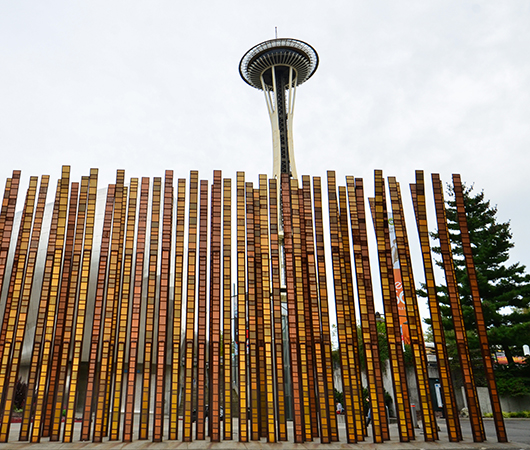
Steps in the Right Direction: A Review of Decibel Festival 2014
Every September, the Decibel Festival brings a wealth of electronic music talent to Seattle, and […]

Every September, the Decibel Festival brings a wealth of electronic music talent to Seattle, and every year, its organizers invite XLR8R to come and check out the proceedings. This year’s edition featured more than 150 artists over the course of five days and nights, and also found the festival, which incredibly continues to be almost entirely staffed by volunteers, moving its headquarters to Seattle’s EMP museum. As always, there was a lot to take in, but we did our best to check out as many things as possible and, more importantly, to take stock of exactly where Decibel is at. The 2014 edition was the festival’s 11th go-round, and despite our fondness for the event—at this point, there is little question that it’s one of the best electronic music festivals in the United States—we’ve also observed its various ups and downs over the years. This year, however, there was a lot more of the former than the latter, and we’ve jotted down a few of the artists, parties, and general trends that made the festival’s 2014 edition particularly potent.
EMP was an excellent home for Decibel.
Our first encounter with the EMP museum was on Wednesday night at Decibel’s opening gala, which featured Sabota, Natasha Kmeto, and Lusine. As soon we arrived, it was obvious that the festival’s new home base was a major improvement. On a symbolic level, the pairing of Decibel with a modern, forward-thinking cultural institution immediately gave the festival more clout. As one staffer expressed to us, it was as though Decibel had grown up a bit. Essentially, the EMP provided Decibel with a modern, technologically advanced facility that not only gave the proceedings a more professional feel, but also enabled organizers to seriously step up their game in terms of what they were capable of presenting. Like many American cities, Seattle doesn’t have a wealth of venues that are well-suited for electronic music, and after years of attending Decibel shows in awkward rock venues and various odd rooms, it felt great to see so many performances in a space that had been specifically tailored for the festival.
Sky Church (photo by +Russ)
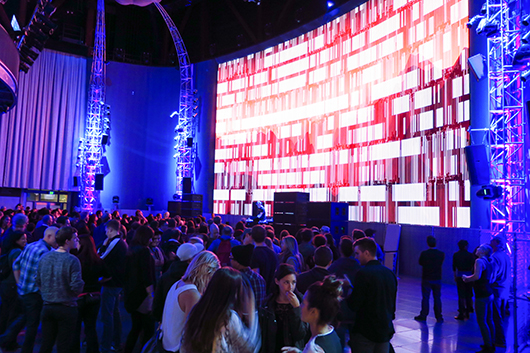
Natasha Kmeto (photo by Drew Tyson)
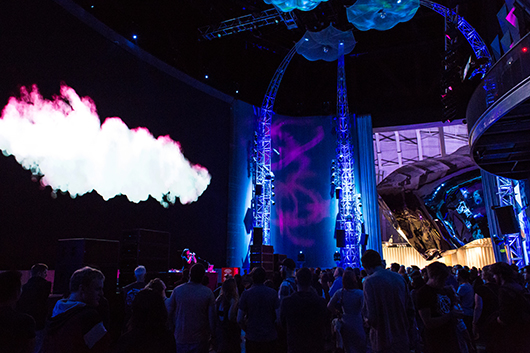
Each night, the EMP museum was actually divided up into three separate venues—Sky Church, Level 3, and the JBL Theater—which meant that a sizable portion of the Decibel festivities took place within a single building. This obviously made things easier for those looking to hop between events, which is something of a necessity for a multi-venue festival like Decibel. All three EMP spaces had great sound, but the Sky Church was far and away the most impressive of the bunch, especially with its vaulted ceiling and the enormous screen that allowed for stadium-sized visuals to be displayed behind the stage. The EMP’s only real downside was the bar situation, particularly at Sky Church, where drinkers were required to remain in a little pen that had been set up in the hallway outside of the room. (Inside Level 3, the alcohol zone was a more generous balcony area above the main floor, while the JBL Theater didn’t allow alcohol to enter at all.)
As Decibel’s main hub, the EMP played host to the Decibel conference, which offered a series of panel discussions and workshops throughout the week. More importantly though, it was also the site of a few incredible performances. On Wednesday night, Arca brought his tour to Decibel with DJ Total Freedom and visual artist Jesse Kanda in tow. In recent weeks, the show has stoked something of a controversy, as its visuals have come under fire for focusing on what some have seen as exploitative images of the human body. Without question, some of the images were highly sexualized (women shaking their asses, male strippers gyrating, obese nudists floating in a pool), but it felt more like Kanda’s work was simply focusing on the inherent oddity of the human form. Granted, many of the clips were likely lifted from YouTube and the visuals weren’t specifically synced to the music, giving the imagery something of an amateurish feel, but at least the visuals had a point of view; to our eyes, Kanda seems intent on exploring the various ways in which people choose to present their bodies and wants to question society’s collective (often disgusted) response. Irrespective of that, it needs to be underscored that the music was the most compelling part of the performance, as Arca and Total Freedom together forged a unique brew that combined chopped and twisted bits of hip-hop and R&B with complex rhythms and mutant basslines. It was ostensibly a high-concept DJ set, something is essentially Total Freedom’s specialty, and though the room was far from full, the show proved to be a compelling treatise on how mainstream and underground music styles are intertwined and ultimately feed off one another.
Arca (photo by Drew Tyson)
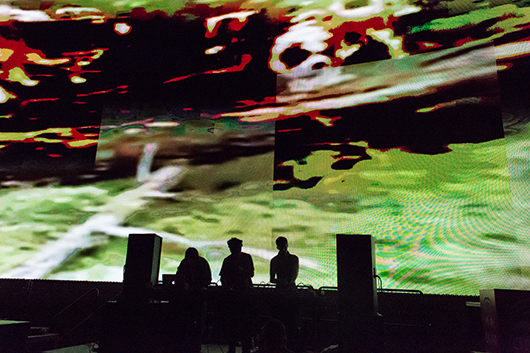
Simian Mobile Disco was another Sky Church highlight, as the UK duo performed live on Friday night, leaning heavily on material from its recent Whorl album and occasionally dipping into its 2012 Unpatterns LP. After being subjected to a subpar set of uninspired big-room house from Robert Babicz, who even played an groan-inducing remix of The Doors’ “Riders on the Storm,” Simian Mobile Disco’s live techno constructions were a real breath of fresh air. Flanked by an array of minimal, ’80s-inspired, videogame-esque visuals, the UK outfit nimbly rolled out bright melodies and a steady rhythmic pulse; without question, the duo’s music was clean, functional, and impeccably produced, but it never sounded overly polished or relied on over-the-top clichés. Simian Mobile Disco has come a long way since its days of remixing Justice and turning out silly (albeit infectious) tracks like “Hustler”; these days, the duo can be counted upon to deliver classy bits of high-quality techno, and its performance at Decibel hammered home its commitment to the sound.
Modern Love put on the festival’s best showcase.
Over the past few years, UK label Modern Love has been well represented at Decibel, and this year’s edition was no different—the imprint took over the EMP’s Level 3 on Thursday night. Heading into the evening, we planned to spend some time at the Modern Love showcase before we started bouncing around to check out some other venues (the Ninja Tune showcase at The Crocodile with Martyn, FaltyDL, and Letherette sounded especially enticing), but in the end, the enticingly dark, doom-ridden sounds on offer made it all but impossible to leave. Even with an early 9:30 p.m. start time, Demdike Stare took control of the room immediately, its trippy, nightmarish music sounding utterly unlike anything we heard all week. Blending elements of dub and industrial with bizarre strains of UK folk and pagan worship, the duo of Miles Whittaker and Sean Canty gradually drove the audience toward a hypnotic, dream-like state, a process expedited by the pair’s psychedelic visuals. Combining snippets of what looked like vintage art films with visually distorted elements of color and light (many of them dominated by ominous streaks of glowing, almost neon green), the imagery exchanged some of kitsch from Demdike’s previous visual array for sheer terror, to glorious effect.
Andy Stott (photo by +Russ)
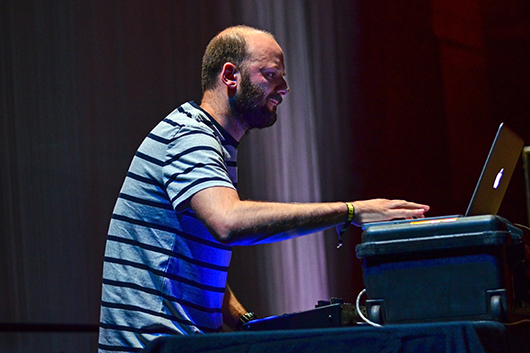
Andy Stott followed, and despite the fact that he was performing at Decibel for the third year in a row, once the music started, we found ourselves unwilling to leave. (Not even the fact that Kangding Ray, Atom™, and Oneohtrix Point Never were all playing upstairs in the Sky Church could entice us to walk out of the room.) Stott has a new LP coming in November, and his set included what sounded like a lot of new music, including several cuts built around a thick, Berghain-style techno pulse and, of course, a number of tracks experimenting with jungle rhythms. Stott’s music always has a real emotional heft, and although his Decibel set wasn’t as strongly driven by the sense of melancholic longing that often defines his work, the performance was riveting and seemingly flew by in a flash.
The energy in Level 3 had jumped significantly during Stott’s set, but it took an exponential leap during the final performance of the evening, a collaborative session from Stott and Whittaker under their Millie & Andrea moniker. Much like the duo’s album from earlier this year, the set was largely centered around jungle, although this was anything but a straightforward recreation of the classic sound. Amen breaks ripped through the dancefloor, but they were paired with other bits of hyperactive percussion, bursts of noise, and a general sense of sonic mayhem. In a word, the set was intense, and while the crowd certainly needed a breather when it all came to an end around 1 a.m., there was little doubt that everyone in attendance had thoroughly enjoyed the ride.
Steffi (photo by Daniel Zetterstrom)
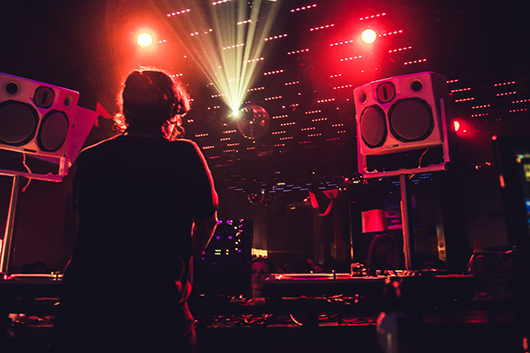
Q played host to great talent all week; unfortunately, being at Q was not a great experience.
When Q opened a couple of years ago, it was talked about with reverence. The venue boasted a Funktion-One soundsystem, could stay open after hours, and was headed up by people with a genuine interest in quality dance music. As such, it seemed like a natural fit for Decibel, and quickly became one of the festival’s go-to venues. Unfortunately though, the club’s promise has slowly fizzled over the years; much like the Capitol Hill neighborhood it calls home, Q appears to be struggling with gentrification, and locals repeatedly told us that new ownership had gradually shifted its attention away from the music while increasingly catering to the tastes of a monied clientele. It’s funny; for all of the complaints we’ve made about Seattle and its aesthetic/fashion tendencies over the past few years, we’d rather party with an army of people in feathered hats, patchwork pants, and ugly loafers than deal with the douchey hordes that have descended upon Q.
In fairness, even with these crowd problems, Q still makes sense as a Decibel venue. The festival’s organizers seemed to consciously move away from Capitol Hill this year, most likely in hopes of avoiding the area’s more dubious club patrons, but Q is still a big room with a big soundsystem where people can party until the sun comes up. As such, we hoped for the best when heading there for the first time on Friday night, when the club played host to a late-night Ostgut Ton showcase with Steffi, Marcel Dettmann, and Anthony Parasole. Given that the party began at 2:15 a.m., after the alcohol had been cut off, we figured that folks who were at the club simply to get wasted would have left already; we were wrong. After making our way through an absolute shit show at the door, we found an overcrowded dancefloor halfheartedly dancing to Steffi’s thunderous techno assault. Things eventually loosened up around 4 a.m. or so, at which point Dettmann had already taken over and eased up on the throttle a bit. We stuck around until after Parasole had gone on around 6 a.m., but even as the night wore on and the douchebags gradually headed for the door, it was impossible to get around the fact the Q’s vaunted soundsystem was badly in need of tuning. Throughout the night, the music sounded terribly flat, and it was clear that the system clearly needed some TLC.
Kink (photo by Daniel Zetterstrom)
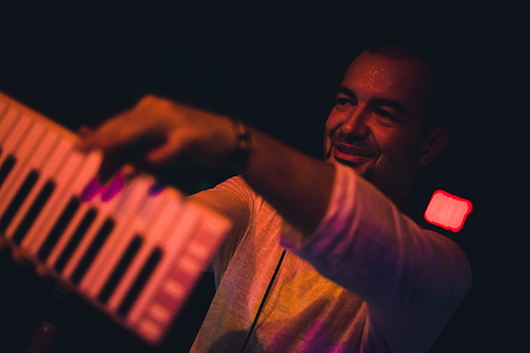
Still, we returned to Q on Saturday night for another after-hours event, this one featuring live performances from Kink and John Roberts. On the whole, this trip to Q was more enjoyable—the club was noticeably less crowded, which definitely helped—and the music on offer was great. When we walked in around 3 a.m., Kink had riled up the crowd with his feelgood vibes, on-stage antics, and overly demonstrative button pushing. He dropped “Existence” toward the end of his set, and the track’s piano riffs made the room explode. However, as good as Kink was, John Roberts was even better. Taking a more subtle approach, he dialed down the energy level and crafted a highly melodic, more subtly grooving brand of house and techno that was an absolute pleasure to hear, especially at that late hour. It almost made the dealing with all of the Q-related nonsense worth it. Almost.
Rrose kicked off a techno-heavy week in style.
As always, the Decibel line-up featured acts from across the electronic spectrum, but this year’s curation was perhaps strongest in the techno realm. We’ve already touched upon the Ostgut Ton and Modern Love showcases, along with the live set from Simian Mobile Disco, but the week also included appearances by the likes of Richie Hawtin, Fluxion, and Recondite, amongst others. Despite all of these big names on the bill, our favorite techno performance may have been the one cooked up by Rrrose on Wednesday night at Re-Bar. Tasked with kicking off the night, Rrose started off slow, filling the room with droning ambient noise before quickly turning up the heat with an array of sharp, industrial-influenced cuts. The music was met with rapturous approval by the dancefloor, which had filled up rather early, and was certainly more warmly received than the following set from Vatican Shadow, whose aggressive on-stage persona, not to mention his more experimental sounds, seemed to rub the crowd the wrong way.
Rrose (photo by +Russ)
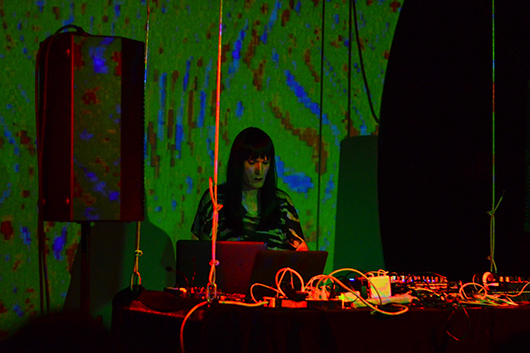
Vatican Shadow (photo by +Russ)
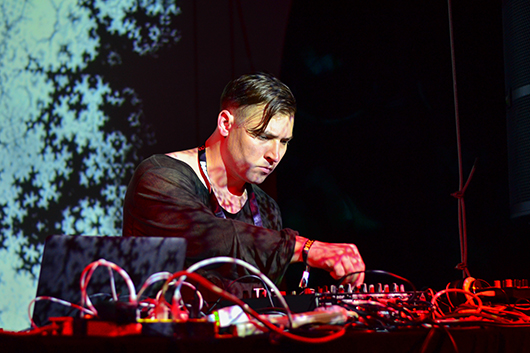
Synth wizard Alessandro Cortini demonstrated his chops.
Heading into the festival, there was a lot of anticipation surrounding the appearance of Alessandro Cortini, the Nine Inch Nails band member who also happens to be a modular synth expert. Wanting to witness the Italian artist’s magic for ourselves, we made a point to check out Friday evening’s Optical 4 showcase at the Illsley Ball Nordstrom Recital Hall. (For the uninitiated, Optical is the name given to Decibel’s annual series of audio-visual performances; these shows often take place in sit-down theaters and auditoriums with high-quality sound and large visual displays.) Coming on after Tri Angle affiliate WIFE, whose heartfelt performance felt a bit too much like karaoke and ultimately left us a bit cold, Cortini was impressive from the jump, his swelling synth explorations lazily filling the room and taking the entranced audience on a floaty journey. Cortini’s visuals only enhanced the experience; beginning with simple projections of sound waves—presumably of the the music he was playing—the images would gradually grow and expand into full-blown lattices that paralleled the music’s swelling timbres.
(Side note: As good as Cortini’s set was, the Optical show that proved to be the real talk of the festival was the Thursday evening session from Max Cooper, whose show involved not only visuals but a number of onstage dancers. We were told by many that the set was one of the week’s real highlights, but unfortunately, we weren’t there to see it.)
Hyperdub was in top form.
Throughout the year, Kode9‘s Hyperdub label has been actively celebrating its 10th anniversary, both with a series of compilations and a number of tour dates around the globe. On Saturday, the imprint’s latest North American jaunt arrived at The Crocodile for Decibel, and offered a line-up that included Kode9, Scratcha DVA, and a joint set from footwork specialists DJ Spinn & Taso. Like most Decibel showcases, the party began early, with DVA hopping onstage at 9:30 p.m. After dropping a few ambient cuts to warm up the floor, he quickly maneuvered into a high-energy mix of grime, upbeat house, and leftfield bass creations. It would have been great to see him play this sort of music a bit later in the night, but those in the crowd didn’t seem to mind; on the contrary, it felt like everyone was eager to get the party started. By the time Kode9 took over around 10:45 p.m., the club was packed, and he absolutely rose to the occasion. After two or three years of nearly nonstop DJing, he’s developed a uniquely effective brew that combines various strands of bass-driven music from both sides of the Atlantic. Grime, hip-hop, garage, house, techno, R&B, footwork… for Kode9, these sounds are all just colors in his varied musical palette, and the man has become something of a master painter behind the decks. We only caught the first half of his set, but at that point, he was already eliciting steady yelps of approval from the crowd, and based upon the texts we received after leaving the club, the energy level on the dancefloor only continued to surge from there. (For the record, we left to go check out Lindstrom, who was performing a few blocks away at the Showbox. It was ultimately a bad decision, as the Norwegian veteran was playing it fairly safe and delivering a cheese-heavy session with just his laptop and a MIDI controller. As his set wore on, it became clear that staying at The Crocodile with the Hyperdub crew would have been the better choice.)
Lusine (photo by +Russ)
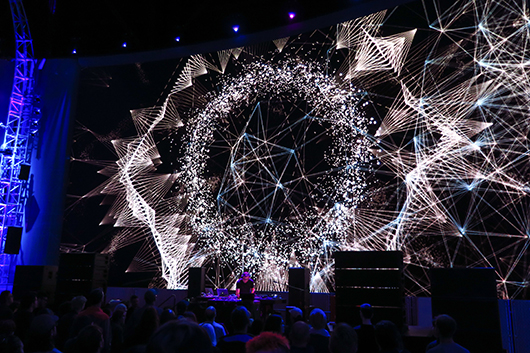
Seattle’s got talent.
Decibel is often celebrated for its ability to attract world-class talent to Seattle every September, but something that is often overlooked is the festival’s commitment to showcasing local artists. Each year, organizers make sure to flesh out the various line-ups with local talent, bringing in not just performers from Seattle, but from the entire Pacific Northwest. In truth, we didn’t get to see as many local acts as we would have liked, but one event in particular reaffirmed our faith in Seattle’s music scene—the Hush Hush label showcase on Friday night in the JBL Theater. We arrived to find Hanssen performing a subdued set that nicely combined twinkly melodics—think ’80s Tangerine Dream—with subtly churning rhythms. It wasn’t dance music per se, but it wasn’t ambient either. Ultimately, it was just really nice to listen to.
Kid Smpl followed Hanssen, and delivered a blistering set that cemented his status as one of Seattle’s brightest talents. While hip-hop undoubtedly resides at the core of his sound, his Decibel set was so much more than just another ho-hum set of instrumental beat music. Folding in elements of noisy, crackling distortion, along with sheets of utterly ominous synths, the music was both haunting and thrilling. Despite the potential parallels to artists like Evian Christ, it’s clear that Kid Smpl is doing his own thing—there was even a bit of jungle in the mix—and is an artist well worth watching in the months and years ahead.
Simian Mobile Disco
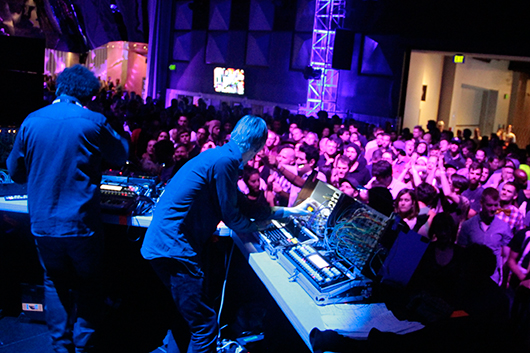
Decibel isn’t perfect, but it’s definitely getting better.
Admittedly, no festival can be perfect, but in past years, Decibel has intermittently struggled with a variety of issues, many of them organizational. As an event that is almost entirely staffed by volunteers, some things are bound to fall through the cracks, even in the best of times, and during previous editions of the festival, the Decibel machine occasionally appeared to strain under the weight of its recent growth spurt.
That being said, 2014 felt like a real step in the right direction. Simply put, this year’s festival seemed to run smoothly. Aside from a few hiccups, the shows ran on time, lines were short, the venues were well staffed, and complaints were few. Moving the festival’s headquarters to EMP undoubtedly helped in this effort, but on a basic level, Decibel 2014 was also a better planned event. Furthermore, instead of trying to grow, this year’s line-up actually scaled things back; Decibel obviously wasn’t a small operation by any means, but things were certainly more concentrated, both on a logistical and stylistic level. By focusing on the things the festival does best, organizers were able to create a more meaningful experience for those in attendance; whether that was intentional or not, it’s to be commended.
Lindstrom (photo by Sam Stenson)
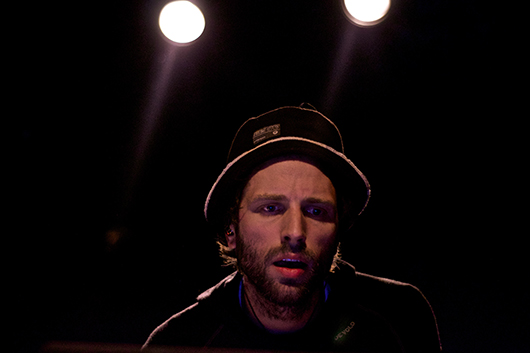
At the same time, there’s still some room for improvement. In all honesty, Decibel could probably be scaled back even further; most of the shows we saw this year were well attended, but we often heard that some of the lower-profile events were half full. In addition, the scheduling of five, six, seven, or more shows each night makes it all but impossible for attendees to see all of the artists they’d like to check out. Especially on the first two nights of this year’s festival, we were forced to make tough choices when two or more headliner-caliber acts were playing at the exact same time. Cutting down the line-up a bit would make these kinds of conflicts less frequent, and would also allow for some of the festival’s weaker venues to be cut from the schedule, improving the overall vibe, not to mention the average sound quality. (If this process also made it so that only venues within walking distance of one another were used, that would be even better. Translation: we spent a lot of money on taxis this year.)
In the end though, we don’t have a lot of negative things to say about Decibel. The festival is clearly put together by passionate people, and their commitment to bringing forward-thinking electronic music to Seattle every year is something well worth supporting. If the 2014 edition is any indication, Decibel appears to be on the upswing; if the festival keeps inviting us, we’ll gladly keep coming back.

